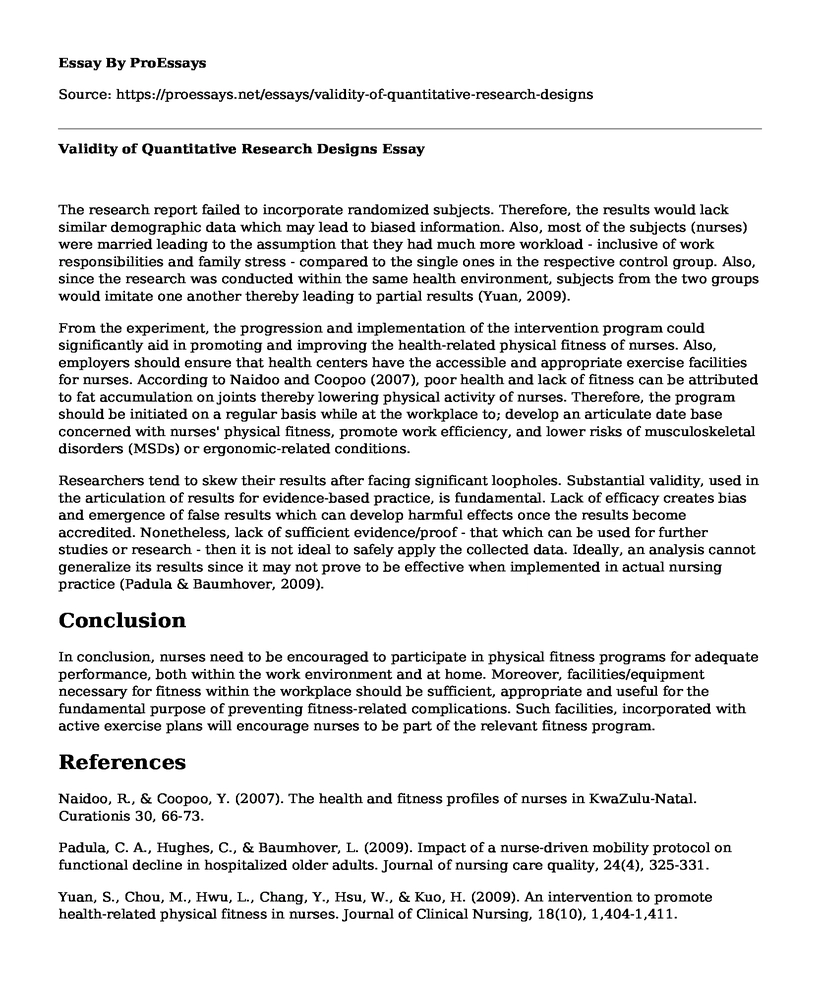The research report failed to incorporate randomized subjects. Therefore, the results would lack similar demographic data which may lead to biased information. Also, most of the subjects (nurses) were married leading to the assumption that they had much more workload - inclusive of work responsibilities and family stress - compared to the single ones in the respective control group. Also, since the research was conducted within the same health environment, subjects from the two groups would imitate one another thereby leading to partial results (Yuan, 2009).
From the experiment, the progression and implementation of the intervention program could significantly aid in promoting and improving the health-related physical fitness of nurses. Also, employers should ensure that health centers have the accessible and appropriate exercise facilities for nurses. According to Naidoo and Coopoo (2007), poor health and lack of fitness can be attributed to fat accumulation on joints thereby lowering physical activity of nurses. Therefore, the program should be initiated on a regular basis while at the workplace to; develop an articulate date base concerned with nurses' physical fitness, promote work efficiency, and lower risks of musculoskeletal disorders (MSDs) or ergonomic-related conditions.
Researchers tend to skew their results after facing significant loopholes. Substantial validity, used in the articulation of results for evidence-based practice, is fundamental. Lack of efficacy creates bias and emergence of false results which can develop harmful effects once the results become accredited. Nonetheless, lack of sufficient evidence/proof - that which can be used for further studies or research - then it is not ideal to safely apply the collected data. Ideally, an analysis cannot generalize its results since it may not prove to be effective when implemented in actual nursing practice (Padula & Baumhover, 2009).
Conclusion
In conclusion, nurses need to be encouraged to participate in physical fitness programs for adequate performance, both within the work environment and at home. Moreover, facilities/equipment necessary for fitness within the workplace should be sufficient, appropriate and useful for the fundamental purpose of preventing fitness-related complications. Such facilities, incorporated with active exercise plans will encourage nurses to be part of the relevant fitness program.
References
Naidoo, R., & Coopoo, Y. (2007). The health and fitness profiles of nurses in KwaZulu-Natal. Curationis 30, 66-73.
Padula, C. A., Hughes, C., & Baumhover, L. (2009). Impact of a nurse-driven mobility protocol on functional decline in hospitalized older adults. Journal of nursing care quality, 24(4), 325-331.
Yuan, S., Chou, M., Hwu, L., Chang, Y., Hsu, W., & Kuo, H. (2009). An intervention to promote health-related physical fitness in nurses. Journal of Clinical Nursing, 18(10), 1,404-1,411.
Cite this page
Validity of Quantitative Research Designs. (2022, Apr 18). Retrieved from https://proessays.net/essays/validity-of-quantitative-research-designs
If you are the original author of this essay and no longer wish to have it published on the ProEssays website, please click below to request its removal:
- The Effects Maternal Depression on the Development of Young Children: Essay Sample
- Essay on Nutrition: Knowing Macronutrients Is Key for Achieving Fitness Goals
- The Significance of Preparing a Literature Review and Problem Statement - Essay Sample
- Teaching Methods for EBP Knowledge: A Literature Review
- Essay Example on Epidemiology: Examining Its Role in Media & Public Health
- Nursing Student Journey at John Hopkins: Overcoming Challenges and Learning - Essay Sample
- Essay Example on Evidence-Based Practice: Enhancing Healthcare Quality and Patient Outcomes







